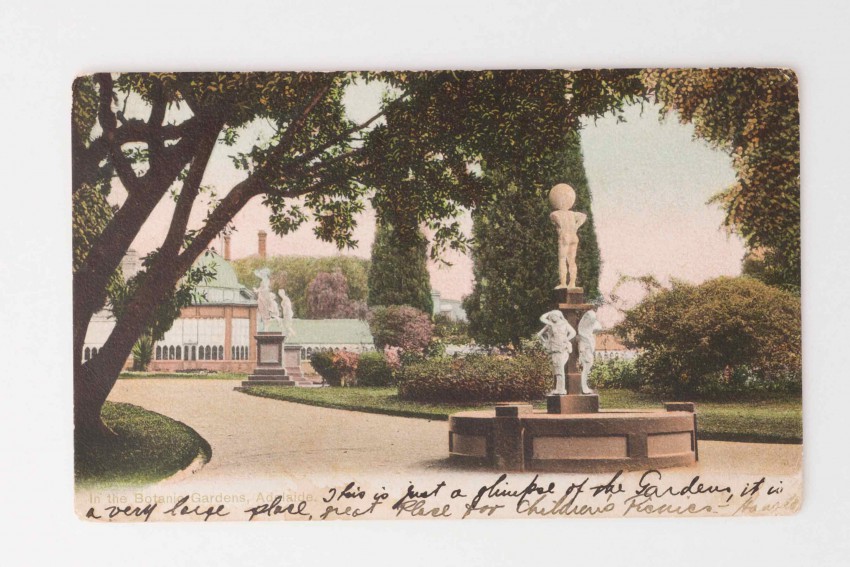Postcards from the Edge of the City

This collection of 300 postcards provides a richer view of the popular consumption of the Botanic Garden up to the commencement of the First World War.
While we’d all agree that we are living in a modern world, it’s not the first time we’ve felt this way. A recent project at the Adelaide Botanic Garden, focussing on picture postcards from the Edwardian era (1901-1914), highlighted the not so obvious reality that the period between Federation and World War One was indeed a modern time. This period was also a time of technological change. Einstein published papers on Theory of Relativity and formulated the well-known (but probably less understood) equation E=mc2. The Wright brothers’ achievements in flight were about to transform the air space and transportation forever. The rail and the postal systems were already highly sophisticated. Locally, the press of the day was heralding electric trams for our city. The Edwardian era was a time of leisure, affluence and modernity. Leisure was, and still is, synonymous with the peace, beauty and tranquillity provided by the Botanic Garden – well in excess of one million visitors annually attest to that. South Australians (and visitors) enjoying the idyllic setting of the Botanic Garden on the fringe of the city provides the backdrop to the current exhibition and a new book. The exhibition, Postcards from the Edge of the City, presents 300 pocket-sized memories of the much-loved Adelaide Botanic Garden. The images on the front tell one story while the hand-written messages on the back provide a glimpse into everyday life from 100 years ago. Remember, across the globe at this time the camera was new, the car was new and the cinema was new. There was a growing appetite for images. Photography was still out of reach for most people. Newspapers of the time used illustrations sparingly, and when they did they were black and white line drawings or engravings. Similarly, the idea of travelling for pleasure was gaining popularity and becoming more affordable and possible for more people – no longer a pursuit of just the wealthy. This sparked an insatiable quest for picture postcards. ‘Insatiable quest’ may sound like hyperbole but in 1903 the German postal system alone delivered more than one billion postcards, while estimates suggest that seven billion postcards passed through the world’s post offices in that year. Some have estimated that the golden age of the postcard (1900-1914) saw 200 to 300 billion postcards produced and posted. In 1906, the Advertiser reported that South Australians spent 50,000 pounds on postcards, when postcards were selling from one penny up to one shilling. South Australia’s population at the time was approximately 360,000 people. Postcards were sold everywhere. There were places in Adelaide where dozens of outlets could be found on the same street. At a time when communication is more focussed on text messages to let our loved ones know that we’ve arrived safely at our destination – or Snapchat, Instagram, Twitter and Facebook – the idea of the postcard seems old fashioned and quaint. The postcard was derided by some in the early 20th Century because it seemed to herald the death of serious letter writing. This was a time when the etiquette and formalities of letter writing (and reply) were taught at school and highly regarded. The notion of brief messages in which grammar was not vital, and cautionary tales about who might read the contents of the message, all seem quite contemporary and similar to the concerns surrounding our current communication practices. It’s worth noting that postcards, at least in the cities, were delivered several times a day. Postcards delivered in the morning could let the recipient know of an intention to visit, and it was possible to have a reply sent and delivered on the same day. The postcard coupled with the effective postal system of the early 20th Century would have appeared speedy, if not as close to instantaneous as imaginable. Interestingly, the personal or private messages on the back are not usually related to the images on the front – the postcard was simply the mode of communication. But more importantly, every single card in the exhibition features an image of the Adelaide Botanic Garden or Botanic Park. The vernacular imagery showcases the sophisticated Botanic Garden that was created for the public of Adelaide. While the Botanic Garden was established as a cultural and scientific institution, the postcards capture and focus on the leisure, beauty and enjoyment of the Adelaide Botanic Garden. A postcard on its own may depict a scene, but this collection of 300 postcards provides a much richer view, and documentary evidence of the popular consumption of the Botanic Garden up to the commencement of the First World War. After that everything changed, and the postcard era was over. Tony Kanellos, Cultural Collections Manager & Curator of the Santos Museum of Economic Botany, Adelaide Botanic Garden Postcards from the Edge of the City Santos Museum of Economy Botany, Adelaide Botanic Garden Open daily from 10am to 4pm until Sunday, April, 26 The 664 page catalogue Out of the past; views of Adelaide Botanic Garden is available from the Diggers shop (just behind the Museum) and is distributed by Wakefield Press to selected bookstores. RRP $50